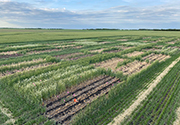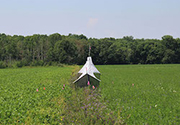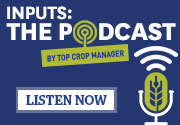| |
| |
 |
 |
| |
 |
|
@{mv_date_MMM d, yyyy}@ |
|
| |
 The feasibility of granting work permits to the family members of temporary foreign workers in the ag sector will be explored in the program’s third phase.
» Read more...
The feasibility of granting work permits to the family members of temporary foreign workers in the ag sector will be explored in the program’s third phase.
» Read more...
The announcement comes as grain companies and farmers’ organizations consider the implications of the Pest Management Regulatory Agency’s ruling to re-evaluate the permitted uses of the synthetic pyrethroid insecticide.
» Read more...
Reflections on Top Crop Manager’s content approach and why knowledge for “down the road” is just as important as current affairs.
» Read more...
|
| |
 |
 |
| |
|
| |

|
| |
|
| |
 As a cover crop, fall rye seeded after harvest has the advantages of providing good fall and spring regrowth to help reduce soil erosion and to suppress weeds. But questions remain around when is the best time to terminate that cover crop in the spring. The most common recommendation has been 14 days before seeding – but that recommendation comes frmor the U.S. midwest, where growth can be much heavier than on the Prairies. So when should one terminate the fall rye cover crop?
» Learn more...
As a cover crop, fall rye seeded after harvest has the advantages of providing good fall and spring regrowth to help reduce soil erosion and to suppress weeds. But questions remain around when is the best time to terminate that cover crop in the spring. The most common recommendation has been 14 days before seeding – but that recommendation comes frmor the U.S. midwest, where growth can be much heavier than on the Prairies. So when should one terminate the fall rye cover crop?
» Learn more... |
| |
 When soybean aphids arrive in late July on the southern winds from the U.S., natural enemies can help keep their populations under control – especially if the habitat surrounding the soybean field is diversified. That’s according to new research at the University of Manitoba, which found that a diverse crop landscape can reduce the colonization of aphids and lead to better control. Predators such as hover flies and lady beetles proved to have a significant impact on aphid populations. What other beneficial practices can keep the aphids at bay?
» Learn more...
When soybean aphids arrive in late July on the southern winds from the U.S., natural enemies can help keep their populations under control – especially if the habitat surrounding the soybean field is diversified. That’s according to new research at the University of Manitoba, which found that a diverse crop landscape can reduce the colonization of aphids and lead to better control. Predators such as hover flies and lady beetles proved to have a significant impact on aphid populations. What other beneficial practices can keep the aphids at bay?
» Learn more... |
| |
|
| |
 It’s the most wonderful time of the year – to look back on the previous season and start planning (or finish planting) for next year! Given some challenging conditions during fall 2021 and summer 2022, how did the winter and spring cereal crops fare?
It’s the most wonderful time of the year – to look back on the previous season and start planning (or finish planting) for next year! Given some challenging conditions during fall 2021 and summer 2022, how did the winter and spring cereal crops fare?
In this episode of Inputs, Sophie Krolikowski, acting cereals specialist with the Ontario Ministry of Agriculture, Food and Rural Affairs (OMAFRA), discusses the 2022 season, starting with planting in fall 2021, how winter cereals planting has gone so far for the 2023 growing season, and some upcoming events and initiatives farmers can participate in.
» Listen now... |
| |
|
| |
|
|
| |
| | |









